Some of the Best Bonsai Artists in the World
The art form of bonsai won’t spread worldwide without the help and passion of some of the best bonsai tree artists.
To understand the history of bonsai and further broaden its reach, it’s important that we get to know and acknowledge some of the key and prominent individuals that made a remarkable impact on the industry.
With that said, let’s look back on the lives and contributions of the world’s top 5 most popular bonsai masters:
1. Masahiko Kimura
The “Magical Technician of Kindai Shuppan”
Bonsai master Kimura is popular across the globe. His works have been featured countless times in many bonsai magazines, blogs, and exhibits.
He’s known in the field as the “Magical Technician of Kindai Shuppan” for breaking many rules of traditional bonsai. His boldness and creativity have helped shape the bonsai art we know today.
One thing that fellow artists associate with Kimura is his love and passion for creating shimpaku juniper bonsai trees.
Bonsai master Masahiko Kimura next to one of his juniper bonsai masterpieces.
Photo courtesy of The International Bonsai Arboretum

Early Life
Masahiko Kimura was born on March 31, 1940, in Ōmiya-ku, Saitama, Japan.
Like most Japanese teenagers at the time, Kimura attended regular school until high school. Then, by his mother’s wish, he became a bonsai apprentice at 15.
For 11 years, he studied and practiced the art of bonsai in one of the most famous bonsai gardens at that time—Toju-en. More than that, he learned under Motosuke Hamano, the first-generation owner of Toju-en and a known bonsai master of his generation.
Bonsai Journey
After his years-long apprenticeship, Kimura started creating his own bonsai masterpieces.
His works became controversial in his first few years for being “different” from traditional bonsai trees. Soon after, his works became popular for their excellent starkness and uniqueness in style.
Kimura continued to create bonsai masterpieces made of shimpaku junipers—eventually becoming his signature species.
This led to his many appearances in bonsai exhibitions and workshops across the globe to teach his style in creating bonsai trees.
Distinctive awards:
- 1988, 1955, 2000, 2001 — Prime Minister’s Award
- 1999 — Minister of Education Award
Apprentices that are popular today:
- Hiroaki Suzuki
- Taiga Urushibata
- Masayuki Fujikawa
Published books about the artist:
- The Bonsai Art of Kimura
- The Magician: Bonsai Art of Kimura 2
Prized Bonsai Masterpiece
One of Masahiko Kimura’s most popular bonsai masterpieces is his hinoki ishizuki bonsai.
Note: Ishizuki bonsai means rock planting or tree planted on a rock bonsai.
This piece is composed of several hinoki cypresses and itoigawa shimpaku junipers of the same age—approximately 40 years old. These were grown from cuttings and were planted in two interlocking slates.
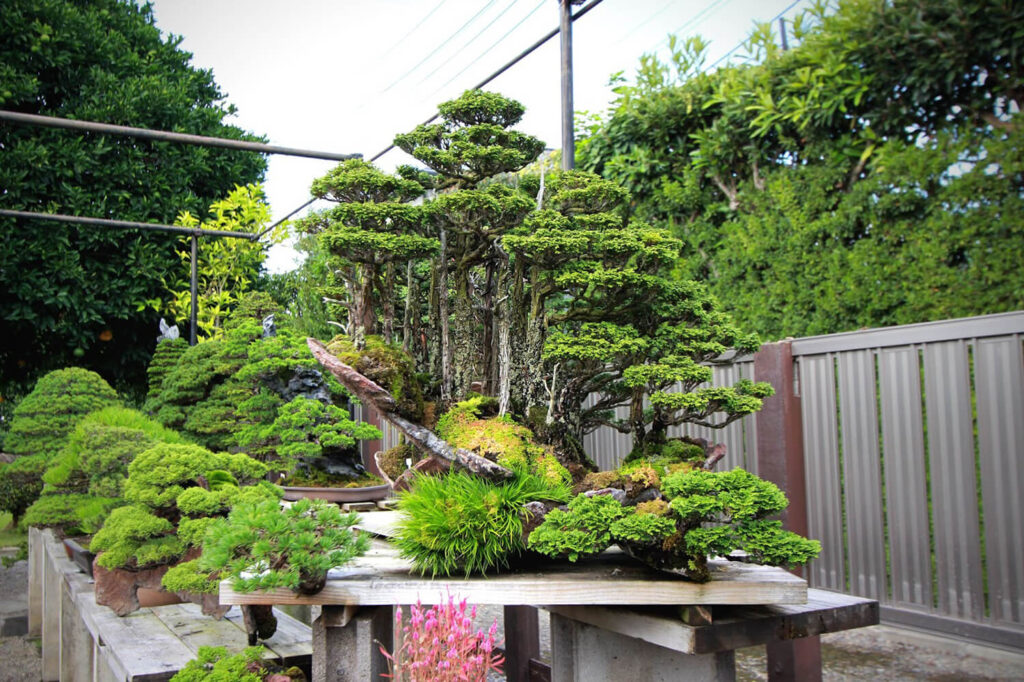
The first and original version of this angled rock planting bonsai is displayed at Kimura’s bonsai garden in Saitama, Japan.
2. Saburo Kato
Master of Ezo spruce forest arrangements
When it comes to Ezo spruce bonsai and forest planting, Saburo Kato is the ultimate bonsai master.
Bonsai master Kato is known for his mastery in cultivating Ezo spruce bonsai trees. Most of his most popular bonsai masterpieces are of this species.
He’s also one of the pioneers in successfully bringing the art form of bonsai to the West. He believed that bonsai making is an art that can bring peace among nations.
The late bonsai master Saburo Kato next to one of his bonsai forests.
Photo courtesy of The National Bonsai Foundation
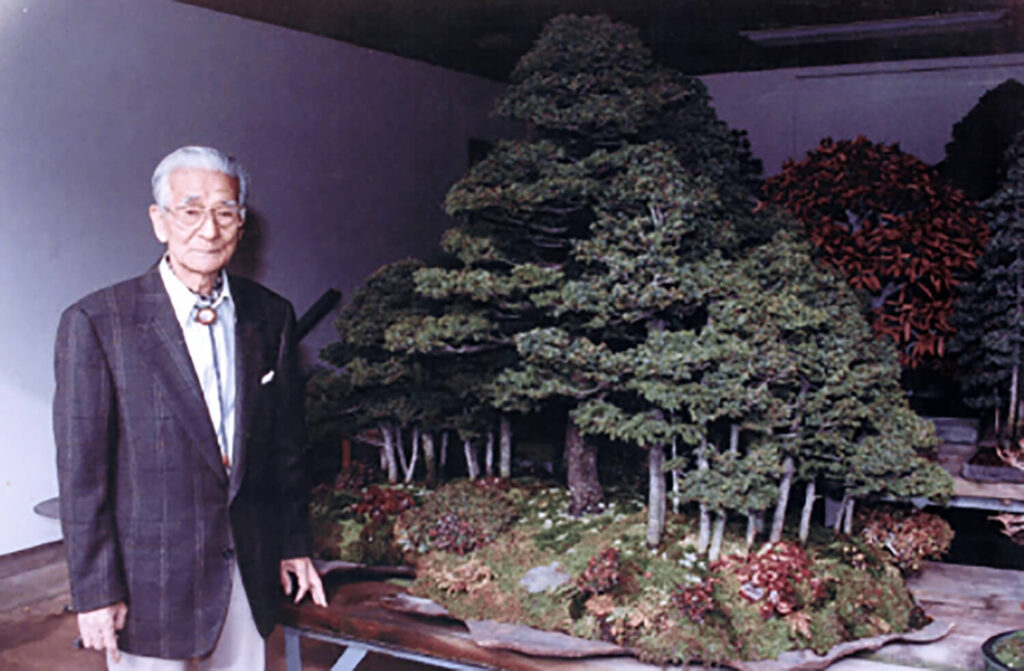
Early Life
Saburo Kato was born in Japan on May 15, 1915.
He’s the eldest son of the late bonsai master Tomekichi Kato II, the second-generation owner of Mansei-en, and the father of Ezo spruce bonsai.
As a teenager, he accompanied his father in collecting Ezo spruce yamadori trees from Kunashiri Island.
When his father died in 1946 at age 64, Saburo Kato assumed the responsibility for Mansei-en. That also became a starting point for Kato to begin his personal bonsai journey.
Bonsai Journey
Saburo Kato’s father was one of the founders of the Omiya Bonsai Village.
So when his father passed away, and Kato took responsibility for the garden, it was Kato that the adjutant of Gen. Macarthur asked to teach bonsai for a year to the members of the American occupational forces post-World War II.
After that, he participated in many bonsai organizations and events within and outside Japan.
In 1965, Kato became one of the founding members and directors of the Nippon Bonsai Association (NBA), which remains active today. Then, in 1969, he founded the Nippon Bonsai Kyodo-Kumiai, a Japanese union for professional bonsai growers, and became its first chief director.
Saburo Kato also participated in the US bicentennial in 1976, where the Japanese government presented 53 bonsai trees and six suiseki stones to the National Bonsai Foundation at the US National Arboretum.
Four years later, he flew to Hawaii for his first US live bonsai demonstration.
This is also where he created one of his famous works, called “Peace Forest.” This bonsai forest is composed of 37 weeping banyans (ficus benjamina), which continue to be restored and refined today.
Apart from his mastery, he was known and acknowledged for his deep passion for sharing the art form of bonsai globally.
Bonsai master Saburo Kaso died on February 8, 2008, in Omiya, Japan—a day before the 82nd Kokufu-ten Bonsai Exhibition, an event he never missed to attend.
Other positions held:
- 1969 — 1st chief director of Nippon Bonsai Kyodo-Kumiai
- 1983 — Executive Director of the Nippon Bonsai Association (NBA)
- 1989 — Executive Director of the World Bonsai Friendship Federation (WBFF)
- 1999 to 2002 — Screening committee Chairman in the annual World Bonsai Contest by Japan Airlines
Distinctive awards:
- 1985 — The Prime Minister’s Medal of Honor
- 1990 — One of six honorees in the Fuku-Bonsai International Honor Roll
- 1999 — Gold Medal Award at the JAL World Bonsai Fair
Apprentices that are popular today:
- Masashi Hirao
- Keiko Yamane
- Keiichi Fujikawa
Published books by the artist:
- 1963 — Forest: Rock Planting and Ezo Spruce Bonsai
- 1967 — The Master’s Book of Bonsai (with Nobukichi Koide and Fusano Takeyama)
- 1988 — The Beauty of Bonsai
Prized Bonsai Masterpiece
Even after Saburo Kato had passed, many of his masterpieces continued to be displayed at several bonsai conventions and exhibits.
In 2017, one of his bonsai masterpieces, the large Ezo spruce forest below, was showcased at Japan’s 8th World Bonsai Convention.

Photo courtesy of Mark Fields
Some of his other works, alongside his father’s Ezo spruce bonsai trees, can be viewed at their Mansei-en bonsai garden at the Omiya Bonsai Village.
3. John Y. Naka
The “Father of American Bonsai masters” & “World Ambassador of Bonsai”
John Yoshio Naka is the most influential bonsai master in the American bonsai industry, especially from the 1950s to 1960s.
He was one of the first bonsai masters to teach bonsai in a non-Japanese language, making learning the art form of bonsai easier and more convenient for non-Japanese aspiring artists.
While bonsai masters in Japan became fond of shimpaku junipers and Ezo spruce…
John Y. Naka had found passion in creating pieces composed of trees native to Southern California.
The late bonsai master John Naka next to his famous Goshin masterpiece.
Photo courtesy of The National Bonsai Foundation
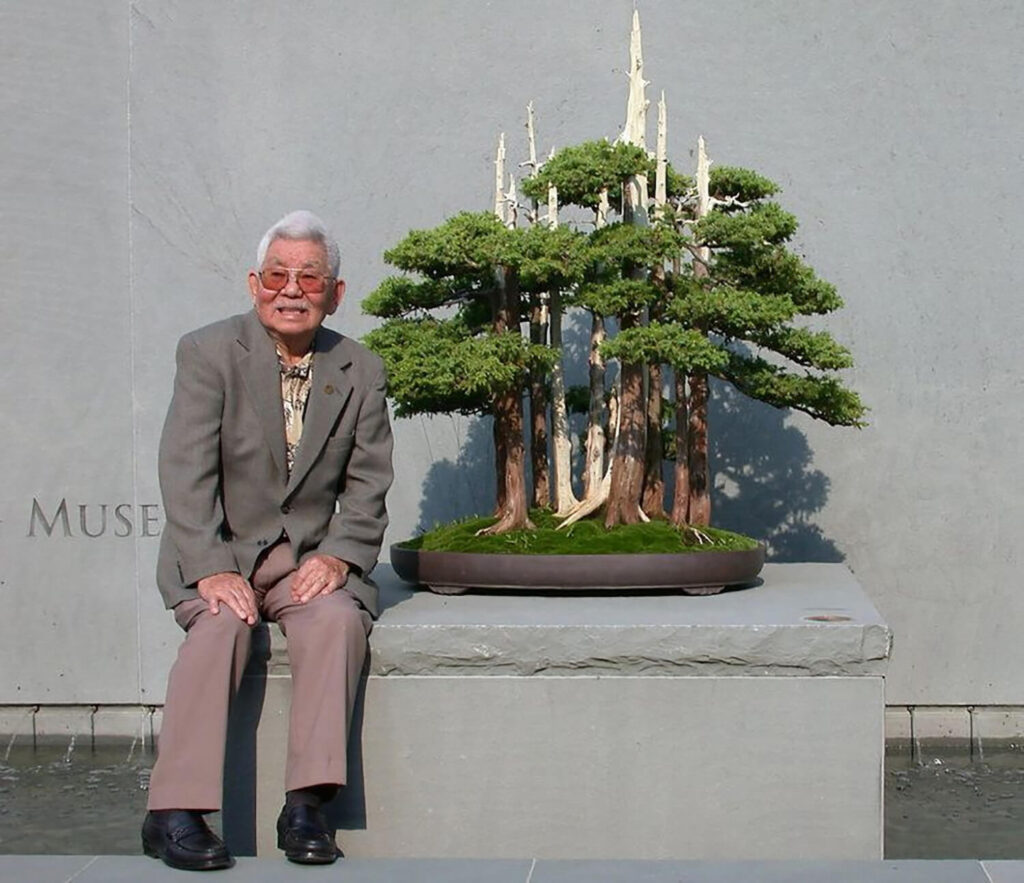
Early Life
John Y. Naka was born on August 16, 1914, in a farming community in Fort Lupton, Colorado. He was the third and last child of his second-generation Japanese-American parents.
When he was 8, Naka and his family returned to their hometown of Kurume, Fukuoka, Japan, to care for his widowed grandfather. While there, he studied the art form of bonsai through his grandfather’s influence.
In 1935, he returned to Colorado to work on his brother’s farm.
A year after, John Y. Naka married his wife, Alice Toshito Mizunaga. Together, they moved to Los Angeles in 1946 and started a landscaping business specializing in Japanese gardens.
It was also during this time when Naka started to pursue bonsai growing.
Bonsai Journey
In Los Angeles, California, he met fellow bonsai artists who helped and motivated him to pursue bonsai art.
In 1950, Naka and his four friends, Joseph Yamashiro, Morihei Furuya, Fusaji B. Nagata, and Mrs. Ai Okumara, created a local bonsai club in Orange County called California Bonsai Club.
Then, in November of 1958, they renamed it the California Bonsai Society (CBS). John Y. Naka served as its president for 32 long years.
He was very active in many nonprofit bonsai organizations, easily making him one of the West’s most well-known and loved bonsai tree artists.
Naka also helped launch the National Bonsai Foundation (NBF) in 1976. It aimed to create a permanent public display for North American bonsai trees at the US National Arboretum in Washington, DC. This pavilion project was granted and was named after himself John Y. Naka.
On May 19, 2008, he passed away at age 89, leaving a legacy and great contributions to the Western bonsai industry.
A month before he passed away, Naka donated his first-ever bonsai tree—a Montezuma cypress—to the National Bonsai & Penjing Museum, which remained displayed today.
Other positions held:
- Honorary advisor to the National Bonsai Foundation
- 1961 — Founder of the Seinan Bonsai Club (later became Nanpu Kai in 1964)
- 1989 — One of the founding directors of the World Bonsai Friendship Federation (WBFF)
- 1991 — Co-signer of the Constitutive Act for the Latin-American Bonsai Federation (LABF)
- 2002 — President Emeritus of the North American Bonsai Federation
- 2002 — Vice-Chairman Emeritus of the World Bonsai Friendship Federation
Distinctive awards:
- 1985 — The Fifth Class of the Order of the Rising Sun awarded by Emperor Hirohito of Japan
- 1992 — National Heritage Fellow in the National Endowment for the Arts
- 1992 — First of the thirteen honorees of the National Heritage Fellowship award
- 2014 — First inductee into the National Bonsai & Penjing Museum’s Bonsai Hall of Fame
Published books by the artist:
- 1973 — Bonsai Techniques I
- 1979 — Bonsai Techniques For Satsuki (with Richard K. Ota and Kenko Rokkaku)
- 1982 — Bonsai Techniques II
- 2005 — John Naka’s Sketchbook (edited by Jack Billet and Cheryl Manning)
Prized Bonsai Masterpiece
One of the world’s most popular and widely-recognized bonsai was made by the late master John Y. Naka.
Goshin, which means “protector of the spirit,” is made of 11 foemina junipers. Each tree represents his 11 grandchildren at the time of its making. Although he started working with it in 1948, it was only around 1964 when his Goshin masterpieces first took shape as a bonsai forest.
In 1984, he donated it to the National Bonsai Foundation, which has been displayed permanently at the US National Arboretum.
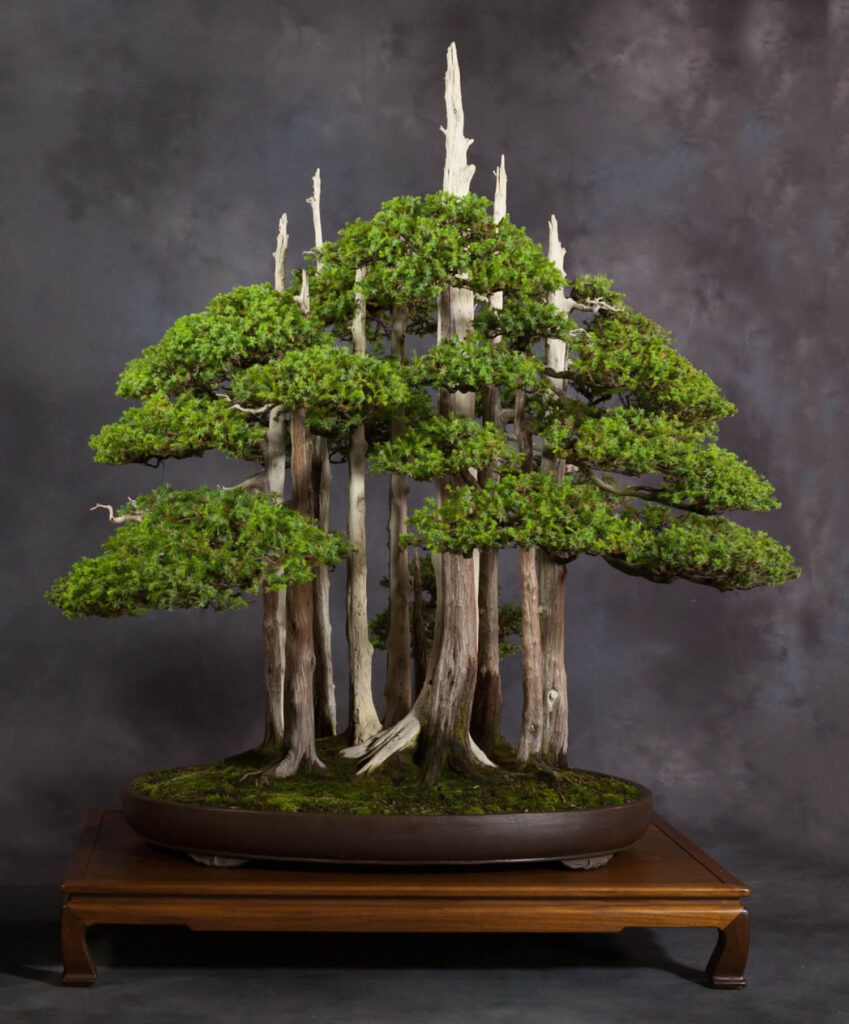
4. Harry Hirao
The “Mr. California Juniper”
Harry Hirao was also one of the most popular bonsai masters in Southern California, next to John Y. Naka.
He was known for his great ability to grow and style raw California junipers into astonishing bonsai trees. Hence he was nicknamed “Mr. California juniper.”
For many years, he had taught many of his apprentices how to properly and artistically collect, style, and maintain bonsai trees.
The late bonsai master Harry Hirao next to his California juniper bonsai masterpiece displayed in the National Bonsai & Penjing Museum.
Photo courtesy of The National Bonsai Foundation
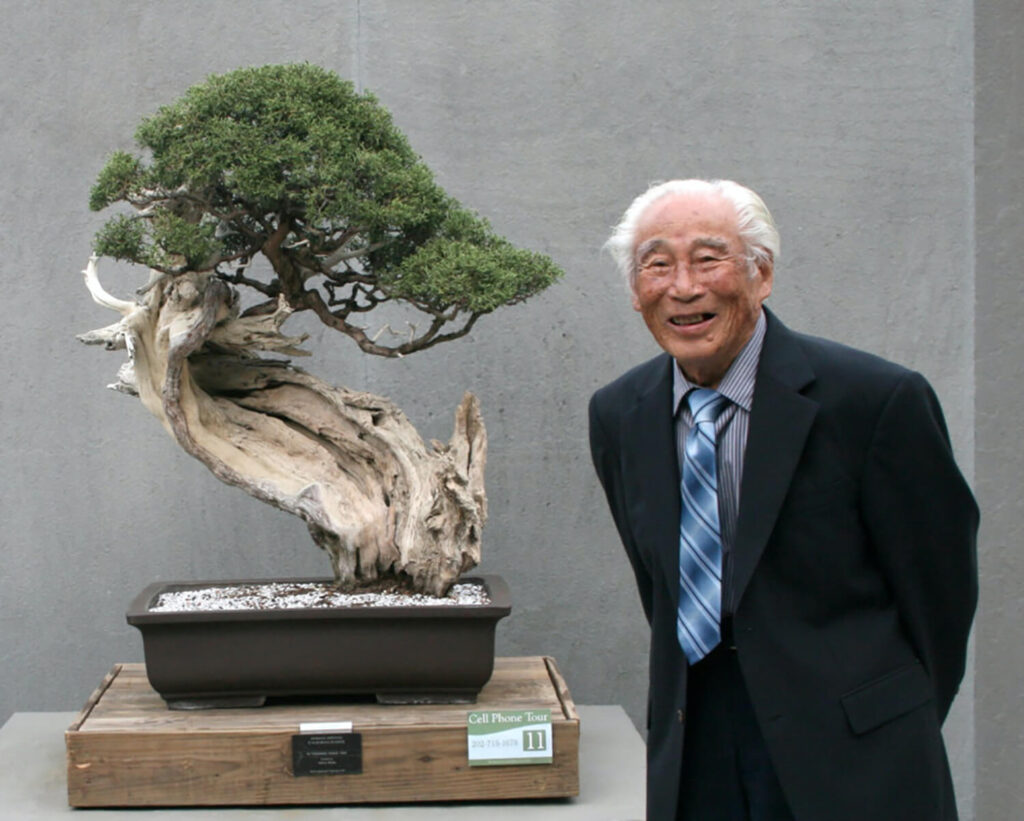
Early Life
Harry Hirao was born on March 12, 1917, in Colorado as a kibei—born in the US but educated in Japan.
When he was 6, he and his family moved back to Japan to study and help on his grandparents’ family farm.
He returned to the US at the age of 16. It was also around this time when he first met and befriended John Y. Naka.
In 1941, he married his wife, Chiyoko Alyce Yamamoto. They lived a simple life as vegetable farmers for several years and had four children.
Later, in 1957, Hirao and his family moved to California and opened a gardening and landscaping business. This is also where his bonsai journey soon began.
Bonsai Journey
Unlike most bonsai masters, Harry Hirao’s interest in bonsai didn’t occur until his middle-aged years when he heard again from his friend John Y. Naka.
He studied bonsai art in the 1960s under Naka for 15 years. Then, later on, he becomes a bonsai instructor himself.
In 1977, he and his friend Larry Ragle created Kofu Bonsai Kai in Orange County. Their club holds many events and activities, including collecting yamadori trees in the Jawbone Canyon in the Mojave Desert, where Hirao was permitted to dig.
Many of his fellow bonsai tree artists and apprentices call him “the mountain goat.” That’s because he was quick and fast in jumping through streams and finding bonsai and suiseki materials to keep.
Everyone knew Hirao as a very warm and welcoming person. Each time he met someone, Hirao would often give a suiseki stone to guests as an appreciation gift.
Bonsai master Harry Hirao passed away in July 2015 at 98—making him one of the last living members of a group of Southern California bonsai artists.
To acknowledge his great contributions to the American bonsai industry…
The National Bonsai & Penjing Museum named their reception area the “Harry Hirao Room.” It was opened at the same time as the John Y. Naka North American Bonsai Pavilion.
Other positions held:
- Board member of the National Bonsai Foundation
- Member of the Board of Directors of the National Bonsai & Penjing Museum
Distinctive award:
- 1981 — “Ryoku Hakiju Yukosho” Medal honored by Prince Takamatsu of Japan and by the Japanese Agricultural Society
Prized Bonsai Masterpiece
Many of Harry Hirao’s famous bonsai masterpieces are of California juniper species.
This particular one below was collected in 1960.
In 2004, Hirao gifted this California juniper bonsai to the National Bonsai & Penjing Museum, which has been displayed permanently in the museum.

5. Kunio Kobayashi
One of Japan’s leading bonsai artists today
Kunio Kobayashi is one of the bonsai masters today who continually dominates the bonsai industry in and outside Japan for many years already.
He’s known for his impressive skills in styling some of the oldest bonsai trees in the world. Numerous guests frequently visit his Tokyo garden to view these several hundred-year-old bonsai trees.
More than anything, his goal is to help spread the beauty of bonsai across the globe by participating in local and international exhibits and conventions.
Bonsai master Kunio Kobayashi next to one of his bonsai trees in his Shunka-en garden.
Photo courtesy of Sandra Simpson
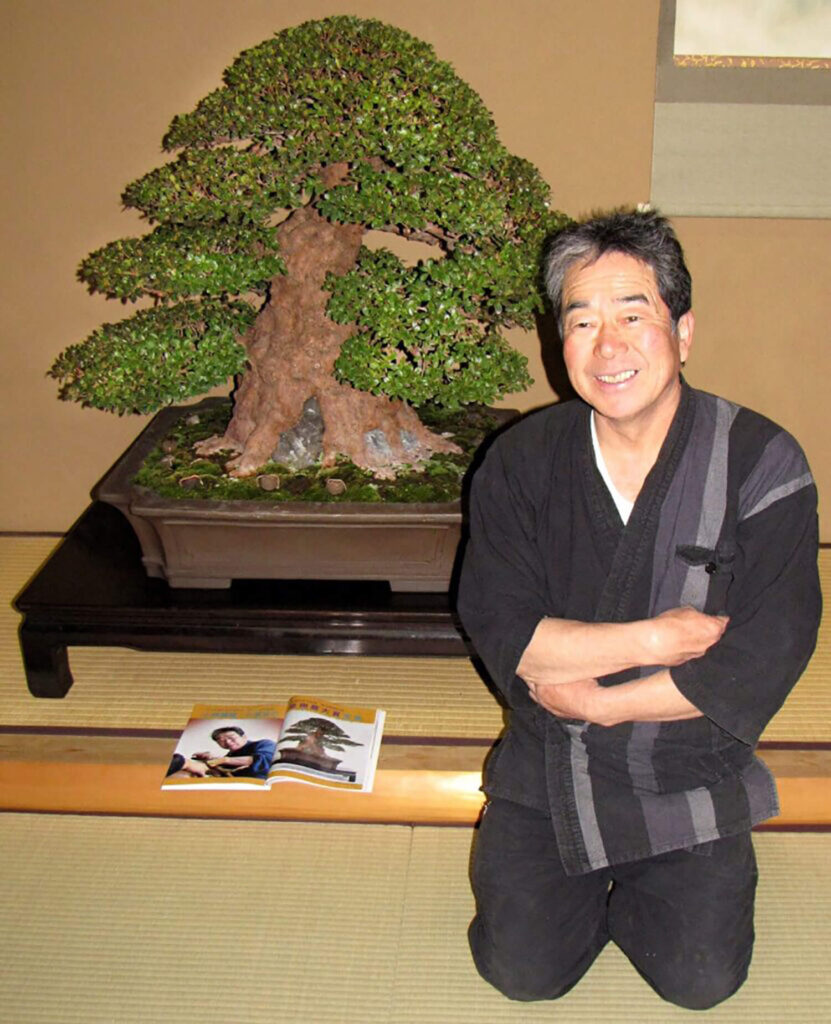
Early Life
Kunio Kobayashi was born in Tokyo, Japan, on April 2, 1948.
He grew up in their family flower nursery, where he learned general knowledge of cultivating and caring for plants.
Bonsai Journey
Unlike other Japan-born and based bonsai masters, Kobayashi only started to take an interest in bonsai art in 1976 in his late 20s.
It all started when he spotted a Japanese white pine bonsai in one exhibit. That particular tree inspired him to explore and study this art, eventually becoming a bonsai master.
At 28, he taught himself everything about styling and caring for bonsai trees. He dedicated 26 years to learning and mastering different bonsai techniques.
Throughout those years, he styled hundreds of bonsai trees—either cultivated from raw materials or bought from auctions.
After 40 years of practicing bonsai art, Kobayashi completely changed his style from creating clean, beautiful bonsai trees to trees that mimic the harshness of nature. Today, he believes in the importance of bringing out the spiritual beauty of the trees.
He calls this particular style “Aji no aru bonsai,” which aims to reflect the wabi-sabi Japanese culture.
Distinctive awards:
- 1989, 1999 — Culture Promotion Award – Edogawa Ward
- 1989, 1992, 1999, 2001 — Sakufu-Ten: Prime Minister’s Award
- 1992, 2003, 2005, 2007, 2010 — Koju-Ten: Koju-Ten Taisho (First Place)
- 1994, 1996 — Ministry of Education Award
- 1995 — Ministry of Agriculture Award
- 1997 — Mainichi Newspaper Award
- 1998 — Japan Association Award
- 2000 — Ministry of Environment
- 2001 — International Art and Culture Award
Prized Bonsai Masterpiece
Kunio Kobayashi’s garden is home to two juniper bonsai trees estimated to be over 800 years old. These two are among the top oldest bonsai trees in the world.
This masterpiece below and the other 800-year-old bonsai tree in his garden have been featured numerous times in many popular bonsai magazines and blogs.
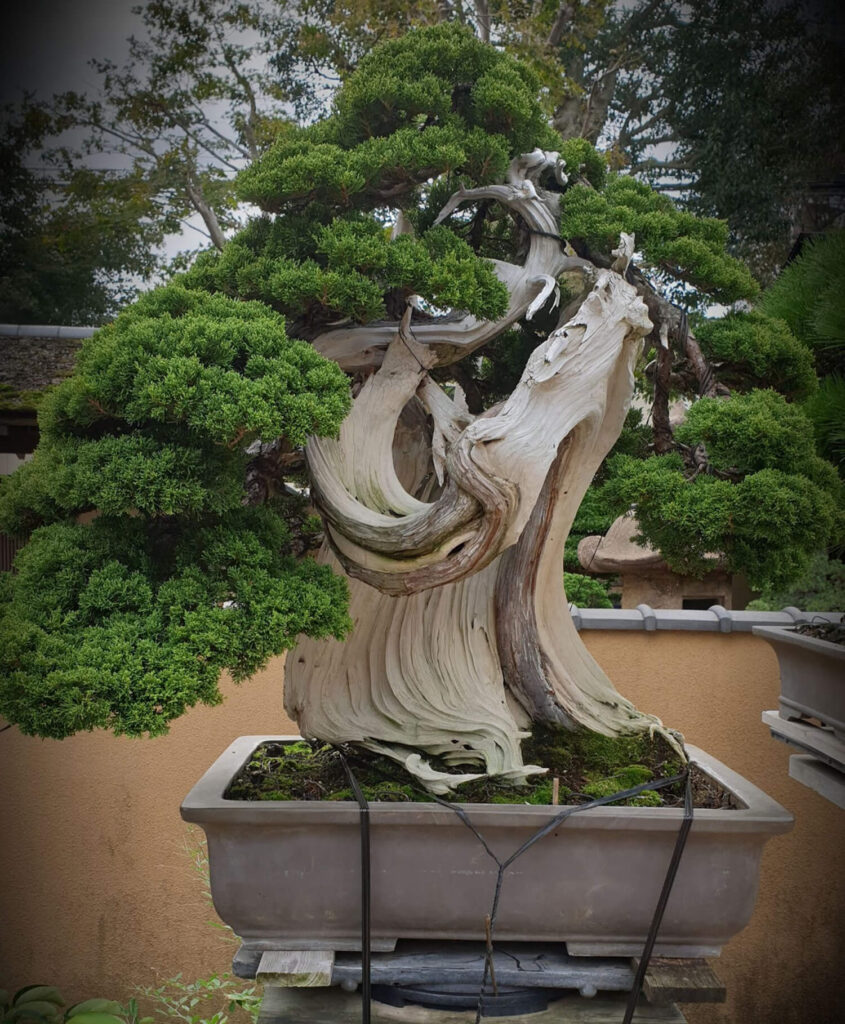
You can view this juniper bonsai in Kobayashi’s Shunka-en museum in Tokyo, Japan which displays over 1000 bonsai trees.
Shunka-en was founded in 2002 to showcase Kobayashi’s masterpieces and offer a bonsai apprenticeship program to interested individuals.
Conclusion
Masahiko Kimura, Saburo Kato, John Y. Naka, Harry Hirao, and Kunio Kobayashi are some of the best bonsai masters of all time who significantly helped spread the art form of bonsai around the world.
Although they have different styles and specialties, they all equally helped shape the bonsai art and culture we know today.
Whether it’s through donating their masterpieces to museums, performing bonsai demonstrations internationally, offering apprenticeships, or writing books…
These world-renowned bonsai masters have unquestionably left great influence and changed the landscape of bonsai art within and outside Japan.
Do you want to become a great bonsai artist as well? If so, continue browsing our library and expand your knowledge.

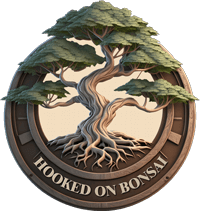
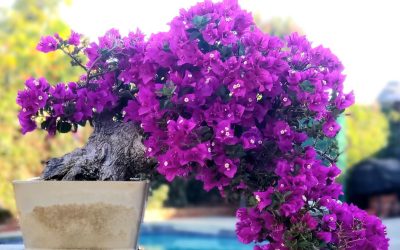
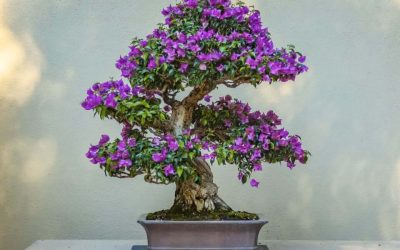
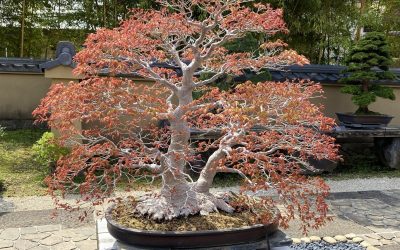
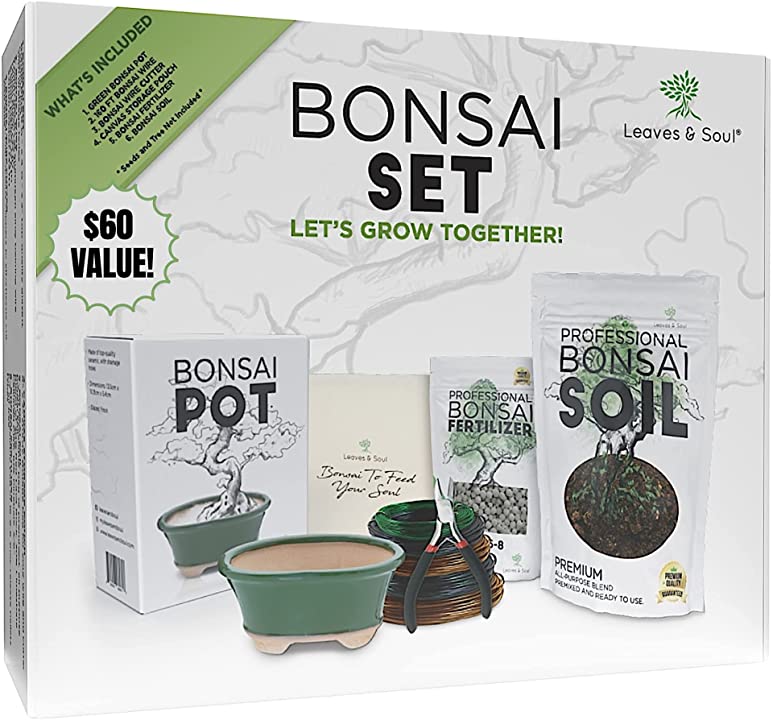
0 Comments